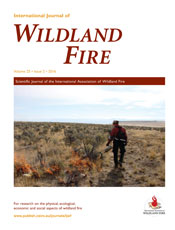International Journal of Wildland Fire
Volume 25
Number 2 2016
We analyse the extent of fire-induced forest degradation in Mato Grosso State, Brazil, in 2000, 2005 and 2010. The largest extent of fire-induced forest degradation is recorded in 2010, in a year with less severe fire season than 2005, potentially indicating increase in fire susceptibility of Amazonian forests.
A dynamic vegetation model is used to assess the effect of fire on tree:grass ratios and the African savanna biome distribution. High fire frequencies were found to maintain tree–grass coexistence under mesic conditions (700–900 mm mean annual precipitation) and the incorporation of fire substantially improved continental simulations of biomes.
Wildfire plays a vital role in grassland ecosystems. Satellite images with a high spatial and temporal coverage offer an effective tool for investigating grassland fires. This study used Landsat imagery that was available publicly to investigate a wildfire disturbance in the Grasslands National Park, Canada and provided insights for fire management in the grasslands.
This study presents an alternative approach to developing severity assessments. A synthesis of challenges using current approaches is presented. The proposed approach links heat transfer dose–response experimental treatments with plant physiology response metrics. The potential of this new approach is demonstrated via a case study.
We present a case study of the Las Conchas Fire (2011), examining how previously burned areas may have influenced fire outcomes. Our analyses quantify fire line effectiveness and avoided exposure, and suggest in particular that the Cerro Grande Fire (2000) helped mitigate fire behaviour and enhance suppression effectiveness.
We evaluated the extent to which previous wildland fire inhibits the ignition and spread of subsequent fire in four large study areas in the western US. Results indicate that wildland fire limits subsequent fire occurrence in all study areas. The longevity of this effect, however, varies among study areas.
This study investigated the effects of winter grazing on fire characteristics. Winter grazing moderated fire behaviour, decreased area burned and reduced fire temperature. This study suggests that winter grazing can decrease wildfire risk and intensity.
A simulation-based framework was used to assess the effect of future fuels, weather and ignitions on burn probability in the Thompson–Okanagan region, British Columbia. Changes in potential vegetation may offset the effect of increases in the number of fire ignitions and fire weather severity on burn probability in this region.
We assessed the impact of low-intensity surface fires in natural sub-arctic stands. Our results indicate long-lasting fire effects on soil CO2 efflux, litter decomposition, soil fungal and microbial biomass, and extracellular enzyme activities. These values were lowest soon after fire and recovered within 40 to 60 years following the fire disturbance.
This study evaluated double sampling to improve photoload estimates of fine woody fuels. We found that double sampling with a regression correction provided a substantial improvement in the accuracy and precision of fine woody fuel load estimates, when sample size is ≥20 and double sampling rate is ≥20%.
Fire front propagation may be modelled by changing values at fixed points within a grid, or by moving markers that are connected to form a front. Here, we demonstrate that both methods produce similar results for a given model of fire spread.
We highlight via a laboratory experiment the potential of repeated burns to reduce black carbon residence times. Our results indicate that for black carbon that remains in situ to be most effective as a net carbon sink, it must be incorporated deep into the organic layer or into the mineral soil matrix before subsequent burning.
We present a new methodology that allowed modelling the amount and spatial distribution of wildfire ash (t ha−1) in a burnt south-east Australian eucalypt forest. This tool can be applied in the region and adapted for use elsewhere, to inform post-fire land management for mitigating the effects of ash, such as debris flows or water contamination.




